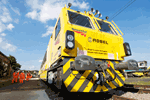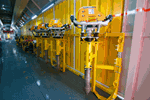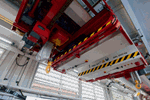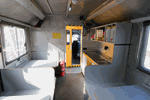View the gallery of the first Network Rail MMT trains.
Working around moving trains is second nature to gangers out on the tracks. But working in a train that’s moving around… that’s going to be a new experience for many of them.
That’s the situation with Network Rail’s new Mobile Maintenance Train (MMT), which is being built by Germany’s Robel. One of its three cars is essentially a mobile shed in which staff can work, protected from the weather and from other trains. But the MMT can also creep slowly along as staff inside work.
The first of NR’s eight MMTs is now at Darlington for extensive tests (usually in clear view of passing trains), as NR and operator Colas Rail get to grips with the opportunities the new fleet offers. The location allows NR to test it in a variety of situations, from the single-track branch to Bishop Auckland to the electrified East Coast Main Line towards York or Berwick. There are also the lines eastwards towards Teesside and Whitby.
Tests started on the Bishop Auckland line on July 27, when the machine deployed between Darlington and North Road stations to complete two welds.
The machine should change the way NR approaches track maintenance. It will certainly change the way gangers work. Currently a maintenance job or minor repair means a gang taking a van to the nearest road access point, and then either carrying their tools and kit to the site or pushing them on a rail trolley. If they forget anything, then it’s a drive back to the depot.
With the MMT, it comes complete with a range of tools, and anything else can be loaded by a day shift before the gang turn up. They board the train and ride to the site in purpose-built accommodation within the traction and supply unit. No more trudging along the cess, or trolley pushing. The MMT can run at up to 60mph, cutting the time taken to reach a repair site.
Once there, work should also be quicker. MMT Supervisor Corey White tells RAIL that the previous weekend his team had changed a concrete sleeper from within the train in one and a half hours. Before the MMT this work could have taken a whole shift.
With the first machine only recently arrived, Network Rail says it’s too early to assess what savings they will bring, but the business case justifying the £5.3 million price tag for each machine was based on savings of £1m per year per machine.
Aboard the MMT during RAIL’s visit is a pallet of track pads. These sit between sleeper and rail, and help track last longer (provided they are changed before they wear out). With onboard machinery to remove and insert the clips that hold the rails to sleepers, changing these pads is made much easier and quicker.
Section Manager Alex Canizo reckons the MMT will change methods, so that NR goes back to routine maintenance in place of renewals. He recalls his early days on track gangs when the ferrules in sleeper chairs would be changed (they ensure chair screws keep a good grip on their chairs), but such techniques have fallen from use, he believes.


















Login to comment
Comments
No comments have been made yet.